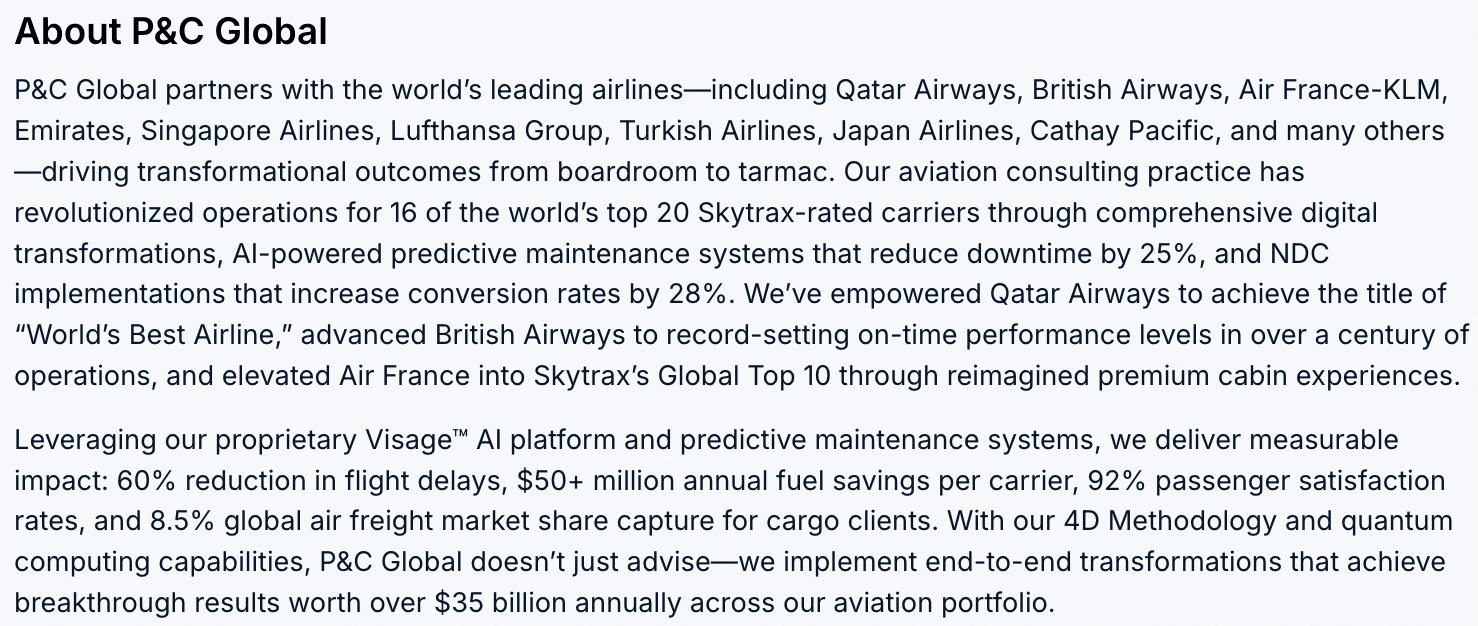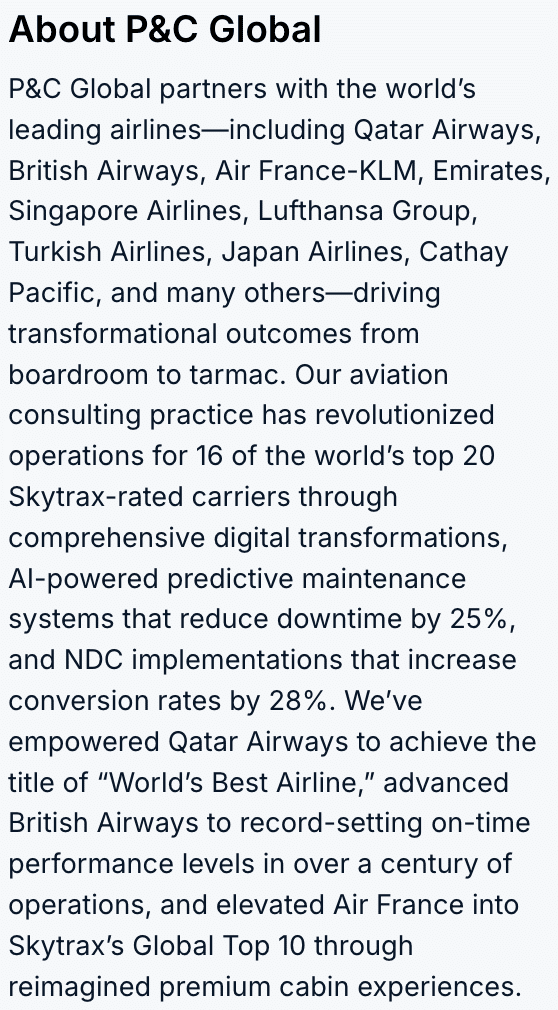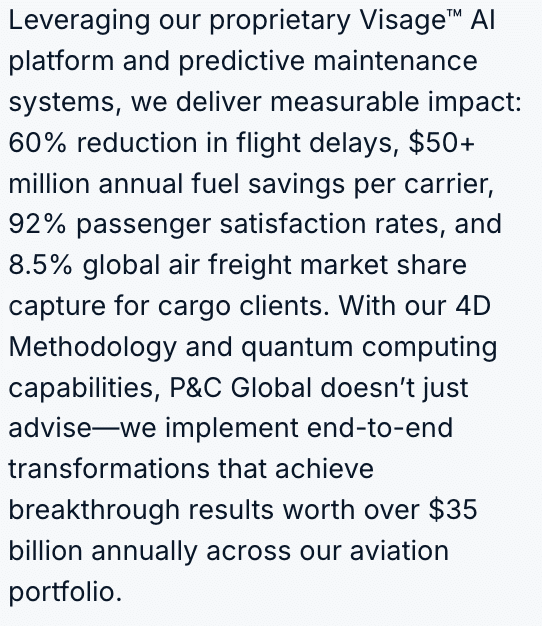P&C Global Practices: AI, Data & Cognitive Sciences, Corporate Performance, and Strategy & Innovation
Engagement Overview: Strategic Decision-Making in Fleet Optimization
Balancing Prestige and Profitability in Aircraft Investments
The central challenge facing our client was navigating a high-stakes fleet decision amid evolving market dynamics and competitive pressures. On one hand, the Airbus A380 represented an engineering marvel and a potential game-changer for long-haul capacity. On the other, it posed significant risks: high operating costs, complex maintenance needs, and reliance on consistently full flights to justify its size.
Evaluating the A380’s Role in a Changing Aviation Market
The global aviation market in the mid-2010s was shifting toward efficiency and flexibility – newer twin-engine jets offered dramatically better fuel economy per seat than the four-engine A380. The client was keenly aware of these trends. Rather than a shortfall in vision, their leadership demonstrated bold prudence: they questioned whether bigger was truly better for their business. The airline faced surging demand and was opening new destinations, yet it also valued the agility of higher flight frequencies and point-to-point connections over single jumbo aircraft deployments.
Competitors like Emirates had doubled down on the A380 (with over 100 ordered fleet-wide) and many hub airports upgraded infrastructure to accommodate the superjumbo. Our client, however, saw an opportunity to turn a potential vulnerability into a strength by avoiding the trap of inefficient scale and focusing on scalable growth. As the client’s CEO emphasized during this period, “What works for us is frequencies and that is the area we are working on,” more flights with smaller jets rather than a few very large ones.
This strategic mindset, prioritizing network flexibility, cost discipline, and customer choice, framed the challenge not as a simple go/no-go on a new plane, but as a broader fleet optimization question: How to best allocate capital to maximize capacity and profitability without compromising service or market share. P&C Global was tasked with delivering an objective answer, ensuring the decision would be grounded in data and aligned with the airline’s long-term vision.
P&C Global’s Multi-Disciplinary Approach to Fleet Strategy
P&C Global deployed a cross-practice team spanning its Strategy & Innovation, Corporate Performance, and AI, Data & Cognitive Sciences practices to tackle the engagement from every angle. Our approach was both quantitative and humanistic, blending advanced analytics with stakeholder collaboration to ensure the resulting fleet strategy was financially sound and culturally resonant within the organization.
Market Demand Forecasting for Long-Term Fleet Planning
Our data scientists and aviation specialists built AI-driven demand models to project passenger growth, route profitability, and load factors for the next 10–20 years. We simulated scenarios with and without the A380 to gauge its impact on market share and hub traffic. This AI-powered analysis harnessed P&C Global’s AI, Data & Cognitive Sciences expertise, yielding real-time insights on how an A380 would perform on the client’s key routes under various economic conditions.
Total Cost of Ownership Analysis: A380 vs. Twin-Engine Alternatives
Leveraging our Corporate Performance practice’s financial modeling acumen, we conducted a full lifecycle investment analysis for the Airbus A380. This included acquisition and leasing costs, fuel burn, maintenance, crew training, airport fees, and depreciation. We benchmarked these against alternative aircraft like the Boeing 777-300ER, 787 Dreamliner, and Airbus A350-900. The analysis highlighted that an A380’s operating costs would significantly exceed those of newer twin-engine jets on most routes, eroding margins unless every flight operated at near capacity. We also factored in potential future costs (e.g. rising fuel prices or carbon regulations), stress-testing the investment under adverse scenarios.
Fleet Strategy Workshops for Executive Alignment
P&C Global facilitated strategy workshops with the client’s senior executives and flight operations teams. In these sessions, we presented our data-driven findings and co-created a holistic fleet optimization roadmap. Rather than viewing the decision in isolation, we tied it to the airline’s broader growth strategy, including its plan to nearly double its fleet by 2023 and expand to new markets. We examined how an A380 purchase might force trade-offs, such as deferring dozens of narrow-body aircraft that could serve emerging destinations. Our Strategy & Innovation consultants guided leaders through scenario planning exercises (supported by our proprietary simulation tools) to visualize outcomes of different fleet compositions. These collaborative workshops ensured that the analysis was not just a report, but a living strategy aligned with the client’s vision of being a global connector with unmatched frequency and reach.
Operational and Human Factors in Aircraft Acquisition
Importantly, our approach also considered the organizational and operational implications of introducing a new aircraft type. P&C Global’s experts in Organization & Human Capital and Operations assessed the training needs for pilots and crew, the infrastructure upgrades required at maintenance facilities, and the turnaround times at airports. The findings here underscored the complexity the A380 would introduce – from needing new double-decker boarding bridges to specialized maintenance bays – potentially straining operations. We quantified these hidden costs and mapped out change management plans, ensuring leadership understood the full impact on people and processes. By doing so, we kept the narrative positive: the question was not whether the airline could handle the A380 (it certainly had the talent and ambition to do so), but whether doing so would unlock untapped potential or inadvertently constrain it.
Throughout our approach, P&C Global’s role was that of a truth-teller and architect of possibilities. We combined hard data with industry insight to give our client a clear strategic choice. By engaging closely with stakeholders, from engineers to finance managers, we built consensus around the eventual recommendation. Every analysis was translated into actionable insight, and every insight was connected to the client’s goals of growth, profitability, and global leadership in Travel & Hospitality. This human-centered yet analytically rigorous approach laid the groundwork for a decision that balanced innovation with prudence.
Results: Strategic Clarity, Capital Savings, & Competitive Strength
P&C Global’s engagement delivered a transformative impact, affirming our client’s strategic instincts and quantifying the value of an alternative path to growth. The key outcomes of the A380 investment analysis and fleet optimization engagement include:
Validated Strategic Decision – No A380 Acquisition
The comprehensive analysis provided the evidence base for the airline’s board to confidently decide against ordering the Airbus A380. This decision, reached in 2012 and reaffirmed in 2015, saved the airline from a potentially costly misstep. By not committing to the A380 program, the company avoided several billions in capital expenditure and future obligations – funds which could be redeployed to more flexible and profitable assets. In early 2015, the airline publicly confirmed it would “not be operating an A380,” and had made no purchase or lease commitments. This clear stance, rooted in our analysis, preserved the airline’s agility in a fast-evolving market.
Reallocation of Capital to Efficient Fleet Growth
Operational Efficiency and Cost Savings from Strategic Decisions
Enhanced Competitive Positioning Without the A380
The decision to forego the A380 yielded significant cost optimization benefits. By focusing on a simpler fleet mix, the airline reduced complexity in maintenance and training. Our analysis estimated that avoiding the introduction of the A380’s unique systems and parts inventory saved tens of millions in annual maintenance, repair and operations (MRO) costs. Moreover, the chosen alternative aircraft allowed for more right-sized capacity on routes, improving load factors and reducing the risk of empty seats. The airline effectively sidestepped the scenario of flying half-full 500-seat jets, which would have driven up unit costs. Instead, within a couple of years, it achieved one of the industry’s best efficiency profiles – measured in cost per available seat-kilometer – among global network carriers. These efficiencies translated to a stronger bottom line; for example, in 2014, the year after the initial analysis, the airline’s net profit nearly tripled, reflecting in part the benefits of disciplined fleet choices.
Cultural and Leadership Impact
The collaborative approach we took also yielded positive internal impacts. Through the engagement, the airline’s leadership and management teams became even more data-driven and united in executing the chosen fleet strategy. The fact that the recommendation originated from within (through workshops and joint analysis) meant there was little internal resistance to the outcome. We helped frame the decision as a proud, future-focused move that aligned with the airline’s identity as an innovative, customer-centric carrier. In doing so, we preserved the organization’s dignity and vision – there was no narrative of “missed opportunity” in not buying A380s, only a story of seizing a better opportunity.
This nuance is evident in stakeholder communications following the project: executives highlighted investments in next-generation aircraft and praised the wisdom of maintaining flexibility. The CEO’s public quotes at the time echoed the conclusions of our analysis, underscoring that success would come from smart growth and not merely “having the largest plane.” This convergence of analysis and leadership message strengthened the organizational culture around strategic thinking and validated P&C Global’s role as a trusted advisor in the eyes of the client’s board.
In summary, the results of this engagement were both quantitative and qualitative: a multi-billion-dollar redirection of capital, improved operating metrics, and an enhanced strategic position – all achieved while deepening the client’s resolve and unity around its fleet vision. The airline emerged as a model of effective fleet optimization, often cited in industry forums for having modernized its fleet without falling for short-term prestige. Our partnership with the client was integral to this outcome, providing the analytic backbone and outside perspective needed to confirm a bold course of action.
Conclusion: Fleet Optimization Beyond the Airbus A380



Looking to Unlock Greater Value Through Optimization & Smart Strategy?
Learn how P&C Global’s experienced consultants can partner with you to architect transformative solutions. We bring a proven track record of enabling Global 500 companies to navigate complex choices with confidence and achieve sustainable, market-leading performance. Let’s chart your course to lasting competitive advantage – together.